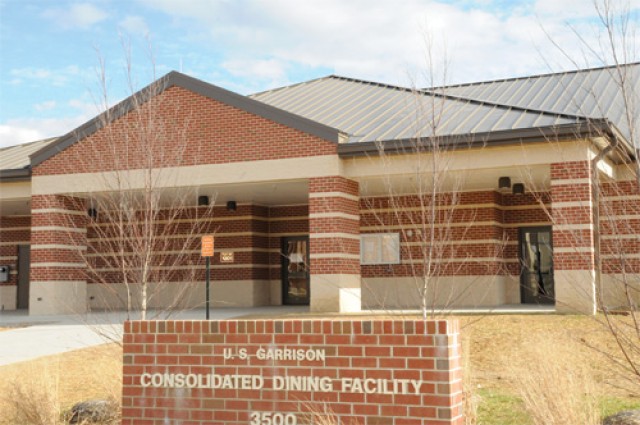FORT LEE, Va. (Feb. 11, 2011) -- Fort Lee has earned its first gold rating through the Leadership in Energy and Environmental Design program.
The newly constructed Air Force/Navy Dining Facility here garnered the award for its design features and functions that achieved high LEED scores for energy savings, water efficiency, CO2 emission reductions, stewardship of resources and more.
The $6.7 million facility opened in June 2010 and features energy-efficient lighting, low-flow water and other energy-saving appliances within the facility. The contractor also worked throughout every stage of the design and construction process to recycle as much waste as possible and to use resources from distributors closer to Fort Lee to reduce the overall carbon footprint the project made on the environment.
According to the U.S. Green Building Council website (www.usgbc.org), LEED is an internationally recognized certification system that provides third-party verification of building and/or community design and construction strategies that emphasize environmental quality, stewardship of resources and sensitivity to the impact of construction. Developed by the USGBC, LEED provides building owners and operators a concise framework for identifying and implementing practical and measurable green building design, construction, operations and maintenance solutions. LEED award levels include certified, silver, gold and platinum.
While LEED silver certification is now the standard for all Army construction projects, contractors are recognizing the importance of achieving higher levels of environmental stewardship and accompanying LEED certification ratings, noted Mike Roach, Fort Lee's resident engineer for the U.S. Army Corps of Engineers.
"A gold LEED rating can't happen without contractor involvement because we can't set standards above silver," Roach said. "In other words, it's up to the contractor to go above and beyond. Fortunately, a lot of them are becoming more environmentally conscious - 'going green' is very important in construction. Most contractors are really getting on board with it."
The contractor for the dining facility project, Leebcor Services LLC, is a service-connected, disabled veteran-owned small business based in Williamsburg. They provide a full range of construction services to the federal government, including design build, general construction, and utilities and site work.
Leebcor worked hard to earn their gold rating, said Roach. The contractor worked with the Environmental Management Office and the U.S. Army Corps of Engineers to ensure the LEED objectives were met.
"The contractor was proud of the building and wanted to do a great job - they were very cooperative with the LEED requirements," said Roach. "This contractor went above and beyond. Some contractors see the easy points and go for them to earn their LEED silver rating. This contractor wanted gold and he went for it."
While the Air Force/Navy Dining Facility project is the first on the installation to earn a gold rating, it shouldn't be the only one as others - like the phase 2 advanced individual training barracks on the Ordnance Campus - show promise of earning similar awards, said Roach.
Emphasizing the importance of the LEED process itself, Debbie Kilpatrick, a NEPA/Sustainability specialist in the EMO, said the program keeps environmental concerns at the forefront of construction planning and community management across the nation.
LEED ratings recognize performance in many key areas - water efficiency, pollution prevention, storm water management, usage of recycled resources, usage of local material resources, design innovation and construction waste management, among others - to encourage environmental stewardship. It also promotes eco-friendly solutions like the installation of bike racks and reserved parking spaces for low-emission cars near businesses. It also brings focus to training and encouraging the end users to be environmentally friendly.
"The design, the construction and the end users - that's how LEED succeeds," Kilpatrick said. "From an environmental management office point of view, we like the LEED program. We like the processes and the thinking that goes into it. It's a step forward for us."
For more information about the LEED program, visit www.usgbc.org. For more information about the Army's involvement in LEED, visit www.sustainability.army.mil/tools/programtools_leeds.cfm.


Social Sharing